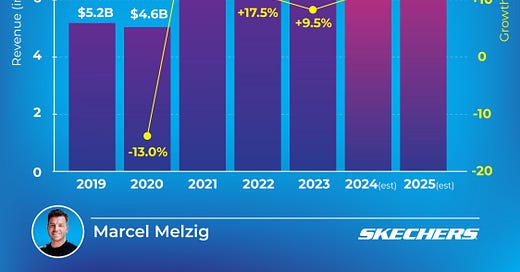Skechers has been a dominant force in comfort and lifestyle footwear for years. Known for its performance walking shoes and everyday wear, the brand has built a highly successful business model centered on affordability, quality, and mass-market appeal.
However, despite its financial strength, Skechers has yet to establish itself within the highly influential sneaker culture—an area where brands like Nike, Adidas, Asics, and New Balance have thrived.
Sneaker Culture: More Than Just Shoes
The sneaker market is no longer just about sports—it’s about cultural influence, exclusivity, and brand perception. Successful brands in this space don’t just sell footwear; they sell a lifestyle.
Nike’s Air Jordan, Adidas’ Yeezy, and New Balance’s high-fashion partnerships have turned sneakers into collectible status symbols.
The global sneaker resale market is projected to reach $30 billion by 2030, driven by limited-edition drops, celebrity collaborations, and influencer marketing.
Even Puma, Salomon, ON, and Hoka have embraced sneaker culture to reposition themselves as trend-driven brands.
Skechers, however, has never been part of this world. It has no sneakerhead credibility, no history of high-fashion collaborations, and a brand image built on function and value—not hype.
Skechers’ Financial Strength in 2024
Despite its absence in sneaker culture, Skechers continues to deliver strong financial results:
Total Sales: $6.76 billion (+11.9% YoY)
Gross Profit: $3.59 billion (+15.4% YoY)
Projected Revenue: $8.975 billion in 2024, on track for $10 billion by 2025
Skechers holds a 5.4% global market share, with particularly strong performances in:
EMEA: +30% revenue growth
Americas: 52% market share
Asia-Pacific: Steady expansion with growing demand
The company also operates an extensive retail network with 5,300+ stores worldwide, including 592 in the U.S.
These numbers reinforce Skechers’ strength, but they also raise a question:
Is financial success enough, or does Skechers need to evolve to stay competitive in a sneaker-driven world?
The Importance of Sneaker Culture in Today’s Footwear Industry
For brands like Nike and Adidas, sneakers are more than just footwear—they are cultural touchpoints.
Sneaker releases are treated as events, often selling out within minutes.
Collaborations with designers, musicians, and athletes generate massive demand.
Limited-edition drops fuel resale markets, where pairs can sell for thousands of dollars.
Even New Balance, once seen as a niche running shoe brand, successfully rebranded by partnering with Joe Freshgoods, Aimé Leon Dore, and Jaden Smith. The result? A brand that now competes directly with Nike and Adidas in both fashion and sneaker culture.
Skechers, however, has focused on performance, accessibility, and affordability—key strengths, but not the factors that drive sneaker culture.
How Skechers Could Break Into Sneaker Culture
If Skechers wants to make an impact in sneaker culture, it will need to shift its approach. Here are five strategic moves that could help reposition the brand:
1. Collaborate with Streetwear Designers & Influencers
New Balance’s rise was fueled by collaborations with respected designers and streetwear brands. Skechers could follow a similar model, partnering with:
Fashion-forward brands like Aimé Leon Dore or Kith
Influential streetwear designers and artists to create limited-edition releases
2. Introduce Limited-Edition Sneaker Drops
Exclusivity drives demand. Skechers could generate hype by launching:
Small-batch premium sneaker collections
Exclusive online drops and raffle-based releases
Collaborations with influencers to build brand credibility
3. Secure High-Profile Athlete & Music Artist Partnerships
Nike has LeBron James and Travis Scott. Adidas had Kanye West and Beyoncé. Skechers could sign:
Basketball players, hip-hop artists, or high-fashion figures who resonate with younger, style-conscious consumers
Athletes outside mainstream sports, similar to how Salomon tapped into the outdoor lifestyle trend
4. Expand into Premium Distribution Channels
Right now, Skechers is primarily sold through mass-market retailers and its own branded stores. To gain credibility in sneaker culture, it would need to enter:
High-end sneaker boutiques like Kith, END., and Stadium Goods
Resale platforms such as StockX and GOAT to build exclusivity
5. Establish a Presence at Major Sneaker & Fashion Events
Sneaker culture thrives on community. Skechers would need to launch exclusive releases and build brand presence at:
ComplexCon, Sneaker Con, and Paris Fashion Week
Industry-relevant collaborations that showcase innovation, not just comfort
Is It Too Late for Skechers to Enter the Sneaker Market?
Skechers has thrived by focusing on comfort, affordability, and functionality. However, the sneaker world is driven by exclusivity, hype, and cultural relevance.
With the right collaborations, distribution strategy, and marketing approach, Skechers could shift its brand perception and become a serious player in sneaker culture. However, this transformation would require bold moves and a willingness to take risks.
The Real Question:
It’s not just about whether Skechers can break into sneaker culture—it’s about whether it should.
📌 Does Skechers need to evolve, or is it better off dominating the market it already owns?
What’s Your Take?
Is there room for Skechers in sneaker culture, or has that opportunity passed? Would a Skechers x Travis Scott or Skechers x Aimé Leon Dore collaboration change how you see the brand?
Want to Keep the Conversation Going?
If you’re into brand strategy, sneaker culture, or retail innovation, let’s connect. I regularly share insights on market trends, business strategy, and brand evolution.
📩 Follow me for more insights!
Thanks for reading! Subscribe for free to receive new posts and support my work.






📌 Skechers financial statement:
https://investors.skechers.com/financial-data/financial-results